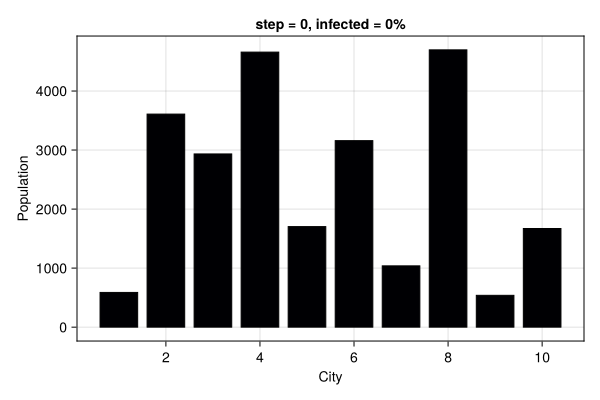Graph model: The spread of SARS-CoV-2#
Source from Agents.jl examples
Here we add one more category of individuals: those who are infected, but do not know it. Transmission rate for infected and diagnosed individuals is lower than infected and undetected.
using Agents, Random
using Agents.DataFrames, Agents.Graphs
using StatsBase: sample, Weights
using LinearAlgebra: diagind
using CairoMakie
CairoMakie.activate!(px_per_unit = 1.0)
Update message: Agents v6
This is a new major version of Agents.jl with lots of cool stuff!
However, from this version onwards, we will stop posting update messages
to the REPL console!
If you want to be updated, follow this discourse post:
https://discourse.julialang.org/t/agents-jl-v6-releases-announcement-post/111678
(and see the CHANGELOG.md file online for a list of changes!)
Define the Model#
@agent struct PoorSoul(GraphAgent)
days_infected::Int ## number of days since is infected
status::Symbol ## S/I/R
end
Initialize the model
function make_model(;
Ns,
migration_rates,
β_und,
β_det,
infection_period = 30,
reinfection_probability = 0.05,
detection_time = 14,
death_rate = 0.02,
Is = [zeros(Int, length(Ns) - 1)..., 1],
seed = 2024,
)
rng = Xoshiro(seed)
@assert length(Ns) ==
length(Is) ==
length(β_und) ==
length(β_det) ==
size(migration_rates, 1) "length of Ns, Is, and B, and number of rows/columns in migration_rates should be the same "
@assert size(migration_rates, 1) == size(migration_rates, 2) "migration_rates rates should be a square matrix"
C = length(Ns) ## Number of cities
# normalize migration_rates
migration_rates_sum = sum(migration_rates, dims = 2)
for c in 1:C
migration_rates[c, :] ./= migration_rates_sum[c]
end
properties = (;
Ns,
Is,
β_und,
β_det,
migration_rates,
infection_period,
reinfection_probability,
detection_time,
C,
death_rate
)
space = GraphSpace(complete_graph(C))
model = StandardABM(PoorSoul, space; agent_step!, properties, rng)
# Add initial individuals
for city in 1:C, n in 1:Ns[city]
ind = add_agent!(city, model, 0, :S) ## Susceptible
end
# add infected individuals
for city in 1:C
inds = ids_in_position(city, model)
for n in 1:Is[city]
agent = model[inds[n]]
agent.status = :I ## Set infected individual
agent.days_infected = 1
end
end
return model
end
make_model (generic function with 1 method)
Initialize parameters
function create_params(;
C,
max_travel_rate,
infection_period = 30,
reinfection_probability = 0.05,
detection_time = 14,
death_rate = 0.02,
Is = [zeros(Int, C - 1)..., 1],
seed = 2024,
)
rng = Xoshiro(seed)
Ns = rand(rng, 50:5000, C) ## City population
β_und = rand(rng, 0.3:0.02:0.6, C) ## Undetected transmission
β_det = β_und ./ 10 ## Detected transmission (set to 10% of undetected)
# Migrate from city i to city j
# People in small cities tend to migrate to bigger cities
migration_rates = zeros(C, C)
for c in 1:C
for c2 in 1:C
migration_rates[c, c2] = (Ns[c] + Ns[c2]) / Ns[c]
end
end
# Normalize migration rates
maxM = maximum(migration_rates)
migration_rates = (migration_rates .* max_travel_rate) ./ maxM
# Migrate to self = 1
migration_rates[diagind(migration_rates)] .= 1.0
params = (;
Ns,
β_und,
β_det,
migration_rates,
infection_period,
reinfection_probability,
detection_time,
death_rate,
Is
)
return params
end
create_params (generic function with 1 method)
Stepping functions#
function agent_step!(agent, model)
migrate!(agent, model)
transmit!(agent, model)
update!(agent, model)
recover_or_die!(agent, model)
return nothing
end
function migrate!(agent, model)
pid = agent.pos
m = sample(abmrng(model), 1:(model.C), Weights(model.migration_rates[pid, :]))
if m ≠ pid
move_agent!(agent, m, model)
end
return nothing
end
function transmit!(agent, model)
agent.status == :S && return
rate = if agent.days_infected < model.detection_time
model.β_und[agent.pos]
else
model.β_det[agent.pos]
end
rng = abmrng(model)
n = rate * abs(randn(rng))
n <= 0 && return
for contactID in ids_in_position(agent, model)
contact = model[contactID]
if contact.status == :S ||
(contact.status == :R && rand(rng) ≤ model.reinfection_probability)
contact.status = :I
n -= 1
n <= 0 && return
end
end
return nothing
end
update!(agent, model) = agent.status == :I && (agent.days_infected += 1)
function recover_or_die!(agent, model)
if agent.days_infected ≥ model.infection_period
if rand(abmrng(model)) ≤ model.death_rate
remove_agent!(agent, model)
else
agent.status = :R
agent.days_infected = 0
end
end
return nothing
end
recover_or_die! (generic function with 1 method)
Initialize the model
params = create_params(C = 10, max_travel_rate = 0.01)
model = make_model(; params...)
StandardABM with 24597 agents of type PoorSoul
agents container: Dict
space: GraphSpace with 10 positions and 45 edges
scheduler: fastest
properties: Ns, Is, β_und, β_det, migration_rates, infection_period, reinfection_probability, detection_time, C, death_rate
Animation#
Observable: The quantity that updates dynamically and interactively Makie plots.
abmobs = ABMObservable(model)
infected_fraction(m, x) = count(m[id].status == :I for id in x) / length(x)
infected_fractions(m) = [infected_fraction(m, ids_in_position(p, m)) for p in positions(m)]
infected_fractions (generic function with 1 method)
Connect (lift) observables to model states
fracs = lift(infected_fractions, abmobs.model)
color = lift(fs -> [cgrad(:inferno)[f] for f in fs], fracs)
title = lift(
(m) -> "step = $(abmtime(m)), infected = $(round(Int, 100infected_fraction(m, allids(m))))%",
abmobs.model
)
Observable("step = 0, infected = 0%")
Figure
fig = Figure(size = (600, 400))
ax = Axis(fig[1, 1]; title, xlabel = "City", ylabel = "Population")
barplot!(ax, model.Ns; strokecolor = :black, strokewidth = 1, color)
fig

Animation
vio = Makie.Record(fig; framerate = 5) do io
for j in 1:30
recordframe!(io)
Agents.step!(abmobs, 1)
end
recordframe!(io)
end
vio |> display
This notebook was generated using Literate.jl.